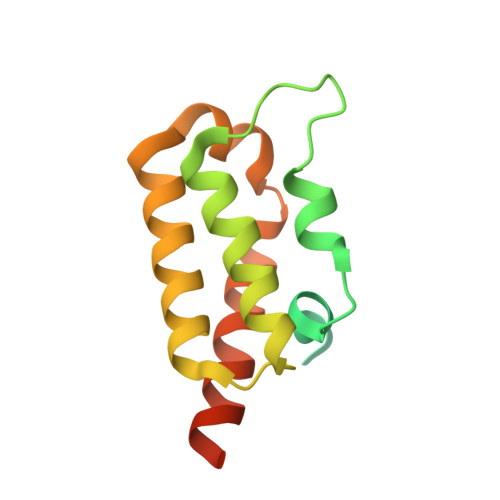Structure and membrane-targeting of a Bordetella pertussis effector N-terminal domain.
Yahalom, A., Davidov, G., Kolusheva, S., Shaked, H., Barber-Zucker, S., Zarivach, R., Chill, J.H.(2019) Biochim Biophys Acta Biomembr 1861: 183054-183054
- PubMed: 31487494
- DOI: https://doi.org/10.1016/j.bbamem.2019.183054
- Primary Citation of Related Structures:
6RGN - PubMed Abstract:
BteA, a 69-kDa cytotoxic protein, is a type III secretion system (T3SS) effector in the classical Bordetella, the etiological agents of pertussis and related mammalian respiratory diseases. Like other cytotoxicity-mediating effectors, BteA uses its multifunctional N-terminal domain to target phosphatidylinositol (PI)-rich microdomains in the host membrane. Despite their structural similarity, T3SS effectors exhibit a variable range of membrane interaction modes, and currently only limited structural information is available for the BteA membrane-targeting domain and the molecular mechanisms underlying its function. Employing a synergistic combination of structural methods, here we determine the structure of this functional domain and uncover key molecular determinants mediating its interaction with membranes. Residues 29-121 of BteA form an elongated four-helix bundle packed against two shorter perpendicular helices, the second of which caps the domain in a critical 'tip motif'. A flexible region preceding the BteA helical bundle contains the characteristic β-motif required for binding its cognate chaperone BtcA. We show that BteA targets PI(4,5)P 2 -containing lipoprotein nanodiscs and binds a soluble PI(4,5)P 2 analog via an extensive positively charged surface spanning its first two helices, and that this interaction is weaker for PI(3,5)P 2 and abolished for PI(4)P. We confirmed this model of membrane-targeting by observation of BteA-induced changes in the structure of PI(4,5)P 2 -containing phospholipid bilayers using small-angle X-ray scattering (SAXS). We also extended these results to a larger BteA domain (residues 1-287), confirming its interaction with bilayers using calorimetry, fluorescence and SAXS methods. This novel view of the structural underpinnings of membrane targeting by BteA is an important step towards a comprehensive understanding of cytotoxicity in Bordetella, as well as interactions of a broad range of pathogens with their respective hosts.
Organizational Affiliation:
Department of Chemistry, Bar Ilan University, Ramat Gan 52900, Israel.
















